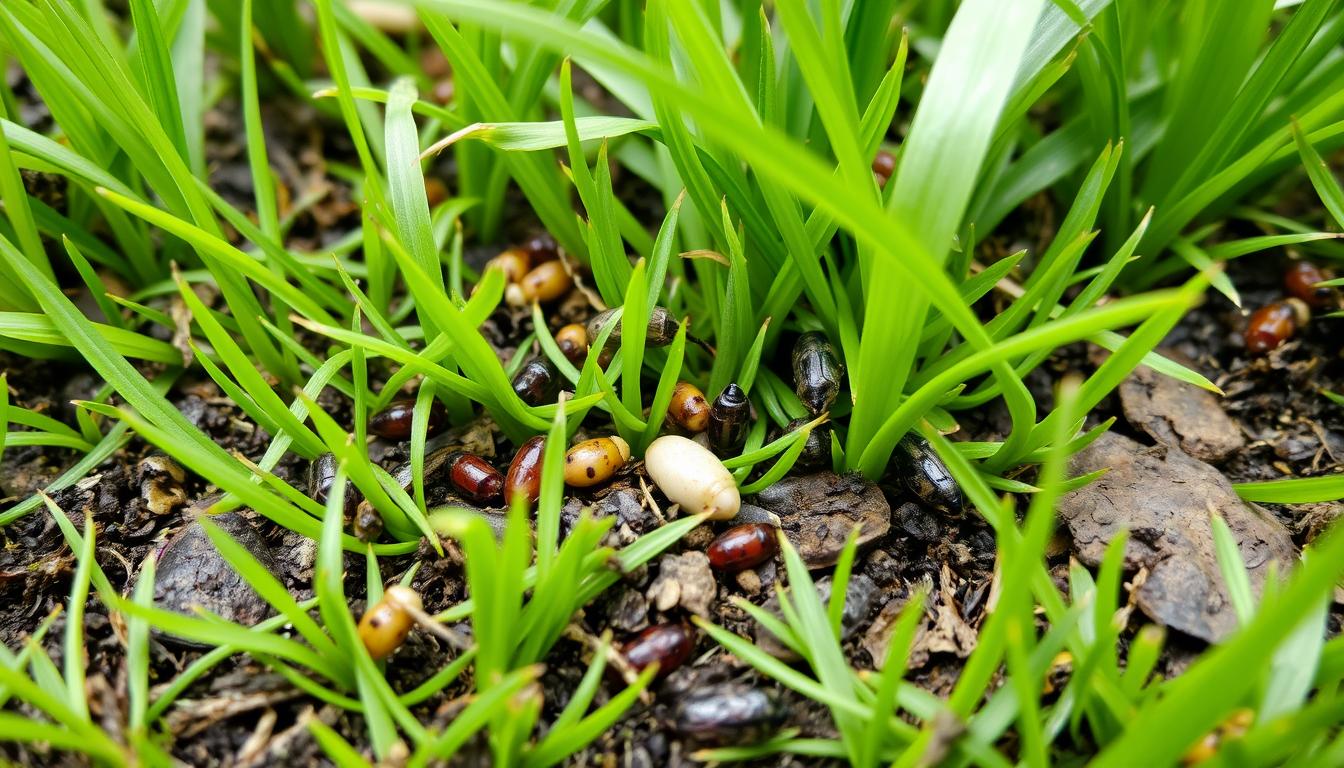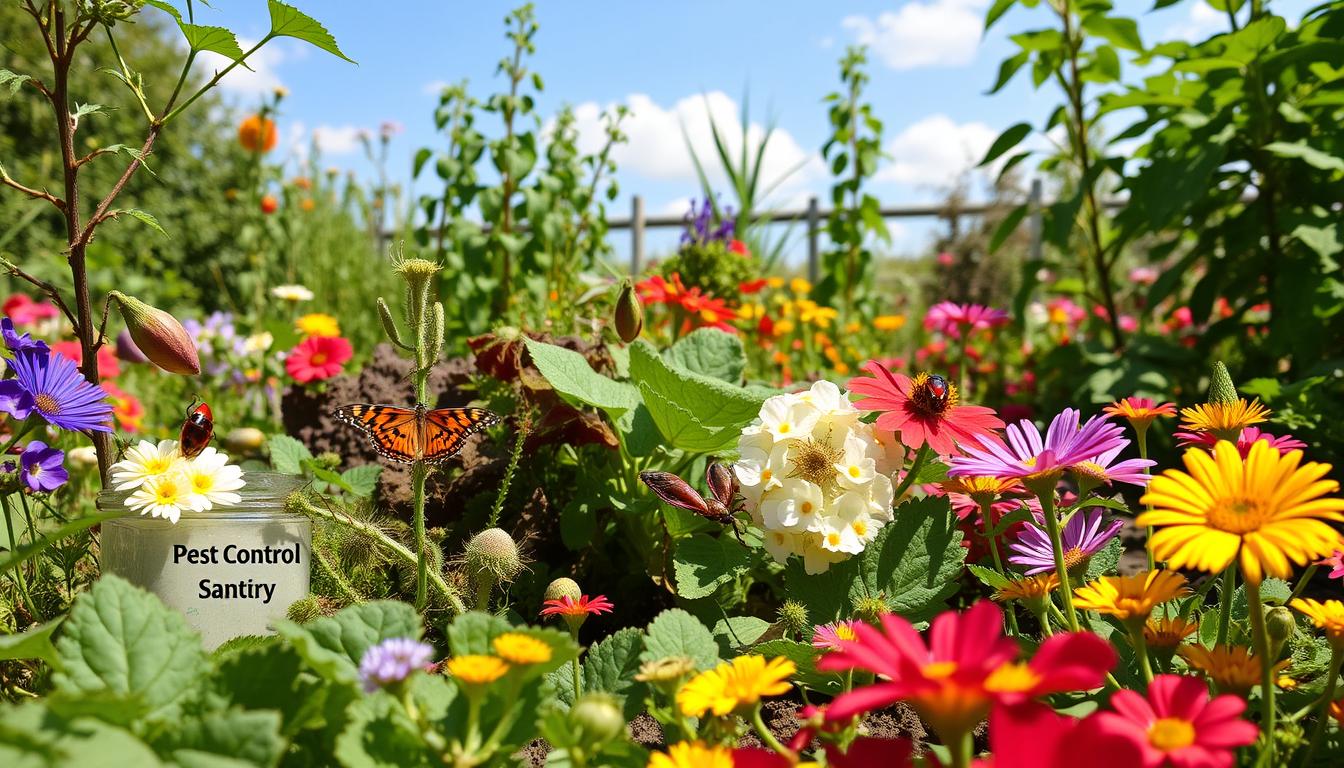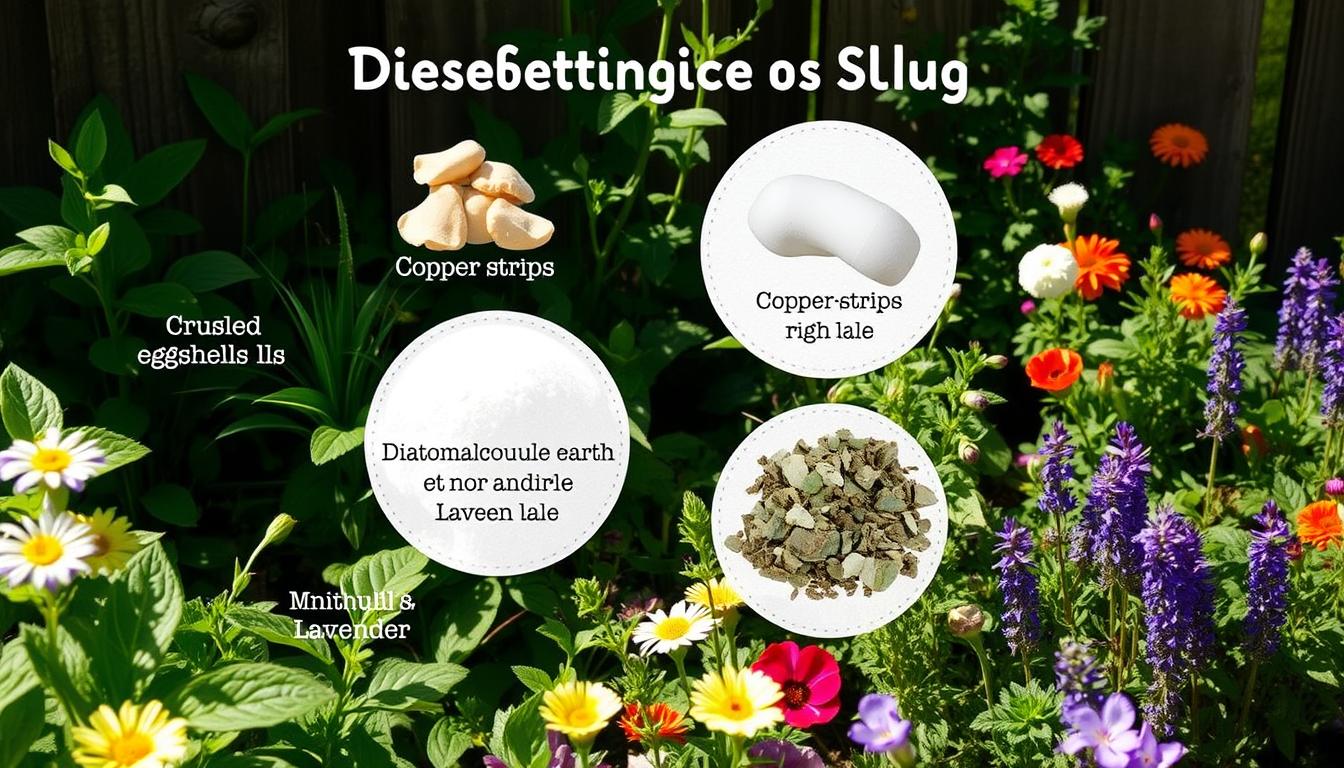Many gardeners face challenges with pest control. They often turn to chemical pesticides, which can harm the environment. But, there’s a greener and more effective way: using companion plants to repel pests naturally.
This method pairs plants that naturally keep pests away with those that pests target. It creates a balanced garden ecosystem, reducing the need for harmful chemicals. By using companion plants, gardeners can grow healthy, sustainable gardens.
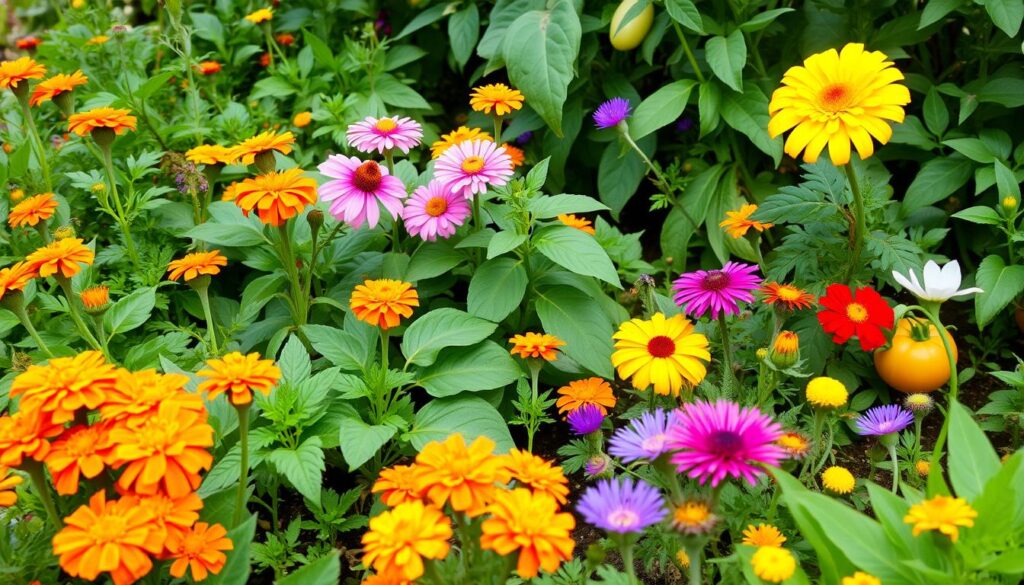
Companion planting is based on the idea that some plants can repel or attract insects. They can also improve growth and flavor. This natural approach helps gardeners keep their gardens healthy without harming the environment.
By choosing pest-repellent plants and using companion planting, gardeners can cut down on chemical use. This makes their gardens more sustainable. Companion planting is a simple, effective way to keep gardens healthy and is key to natural pest control.
Introduction to Companion Planting
Companion planting pairs plants that grow well together. They have similar needs and can resist pests better. This technique helps gardeners create strong, diverse gardens that fight off pests and diseases.
As gardeners look to reduce their environmental impact, natural pest control methods like companion planting are gaining popularity. They offer a way to keep gardens healthy without harming the planet.
Key Takeaways
- Using companion plants to naturally repel pests is an eco-friendly and effective approach to pest control
- Companion planting for pest control involves pairing plants with natural pest repellent properties
- Natural pest control methods, such as companion planting, can reduce the need for chemical pesticides
- Pest repellent plants can be used to create a balanced ecosystem that minimizes pest damage
- Companion planting is a key component of natural pest control and sustainable gardening practices
- Using companion plants to naturally repel pests can help maintain a healthy and sustainable garden ecosystem
Understanding the Science Behind Companion Planting for Pest Control
Companion planting is a gardening technique that naturally keeps pests away and helps plants grow better. It’s based on science, which helps gardeners create a healthy ecosystem. A good companion planting guide helps pick the right plants to grow together.
Using pest-repelling plants is a key part of companion planting. For instance, basil keeps aphids and mosquitoes away, while marigolds fight nematodes and whiteflies. This way, gardeners can use fewer chemicals and make their gardens more eco-friendly. They can also add beneficial insects to help even more.
Companion planting has many benefits. It makes plants grow better, increases crop yields, and fights pests. With some easy eco-friendly gardening tips, gardens can be both lovely and productive. For example, marigolds with tomatoes and basil with peppers are great combinations.
Chemical Communication Between Plants
Plants talk to each other through chemicals. These signals can attract or repel pests. By knowing these signals, gardeners can pick plants that work well together. Some plants attract good bugs, while others keep pests away.
Natural Defense Mechanisms
Plants have ways to protect themselves from pests and diseases. By choosing plants with strong defenses, gardeners can use fewer chemicals. This makes gardening more sustainable.
Symbiotic Relationships in the Garden
Plants and beneficial insects have special relationships in the garden. Adding ladybugs and lacewings helps manage pests naturally. This approach is effective and kind to the environment.
Benefits of Using Companion Plants for Natural Pest Management
Companion planting is a natural way to manage pests in your garden. It offers many benefits for gardeners. By using companion plants, you can avoid using harmful chemical pesticides.
This method of organic pest control helps plants and beneficial insects work together. It keeps pest populations in check. Companion planting also improves soil health, makes plants taste better, and makes your garden look great. It’s a key part of organic gardening.
Some of the main benefits of companion planting are:
- Less use of harmful chemical pesticides
- A balanced ecosystem
- Better soil health
- Flavorful and beautiful plants
- It’s cost-effective and good for the environment
By adding companion plants to your garden, you create a natural pest control system. It’s also a natural pest repellent. This approach not only controls pests but also boosts your garden’s health. It’s a great choice for gardeners who want to garden sustainably.
Essential Companion Plants That Repel Common Garden Pests
Choosing the right companion plants is key to planting for pest prevention. These plants naturally repel pests, reducing the need for harmful chemicals. This approach helps maintain a healthy garden ecosystem.
Herbs like basil, mint, and lemongrass are great at keeping insects away. Flowers such as marigolds and nasturtiums also help. Vegetables like hot peppers and garlic can repel pests. Pairing these plants creates a strong defense against garden pests.
- Marigolds with tomatoes to deter nematodes
- Basil with lettuce to repel aphids
- Garlic with roses to repel aphids and other pests
Using companion planting for natural pest repellent strategies makes your garden more sustainable. Choose plants that work well together and thrive in similar conditions. This way, you create a balanced and pest-resistant plant combination.
| Companion Plant | Pest Repelled |
|---|---|
| Marigolds | Nematodes |
| Basil | Aphids |
| Garlic | Aphids, other pests |
Creating Effective Plant Combinations for Pest Prevention
To keep pests away from your garden, mix different plants that repel them. Choose garden pest repellent plants with natural pest-repelling powers. This eco-friendly approach helps your garden stay healthy without harsh chemicals.
For example, marigolds can keep nematodes away from tomatoes. Basil helps protect lettuce from aphids. You can pick the right mix for your garden’s pest problems. This way, your garden becomes strong against pests.
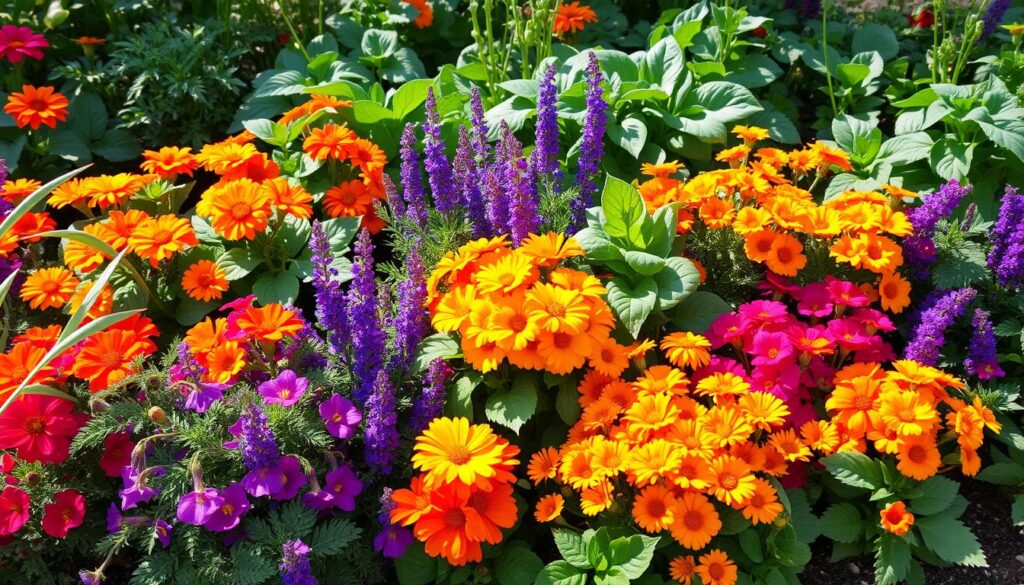
Think about each plant’s pest-repelling abilities and how they grow. Plan your mix carefully. This will make your garden not only beautiful but also pest-free and disease-resistant.
Strategic Placement and Spacing of Companion Plants
Using beneficial plants for pest control is smart. Where and how far apart you plant them matters a lot. This way, you can keep pests away without harming the environment.
Every plant has its own needs. Some need more room to grow, while others can be closer together. Knowing this helps you make a garden that fights pests well.
- Optimal planting patterns, such as alternating rows of different plants or creating a polyculture
- Distance requirements between plants to ensure they do not compete for resources
- Seasonal considerations, such as which plants to plant in different seasons to maintain year-round pest control
By thinking about these things, you can make a garden that’s good for both you and the planet. It’s a smart way to keep pests away and keep your garden healthy.
Common Garden Pests and Their Natural Plant Deterrents
Keeping your garden healthy is key. Using natural plant deterrents is a smart way to fight pests. For instance, garlic and hot peppers keep aphids away. Basil and mint help fend off whiteflies.
Knowing which pests harm certain plants helps. Also, knowing which plants can fight pests is important. This way, gardeners can manage pests before they become a problem.
Intercropping is another great method. It means growing different plants together to avoid pests. Adding beneficial insects like ladybugs and lacewings helps too. This creates a balanced garden ecosystem.
Some plants are naturally resistant to pests. For example:
- Marigolds keep nematodes away
- Nasturtiums repel aphids and whiteflies
- Radishes chase off cucumber beetles
Using these methods helps avoid chemical pesticides. It makes your garden more sustainable. Effective pest management needs a mix of natural deterrents, intercropping, and beneficial insects.
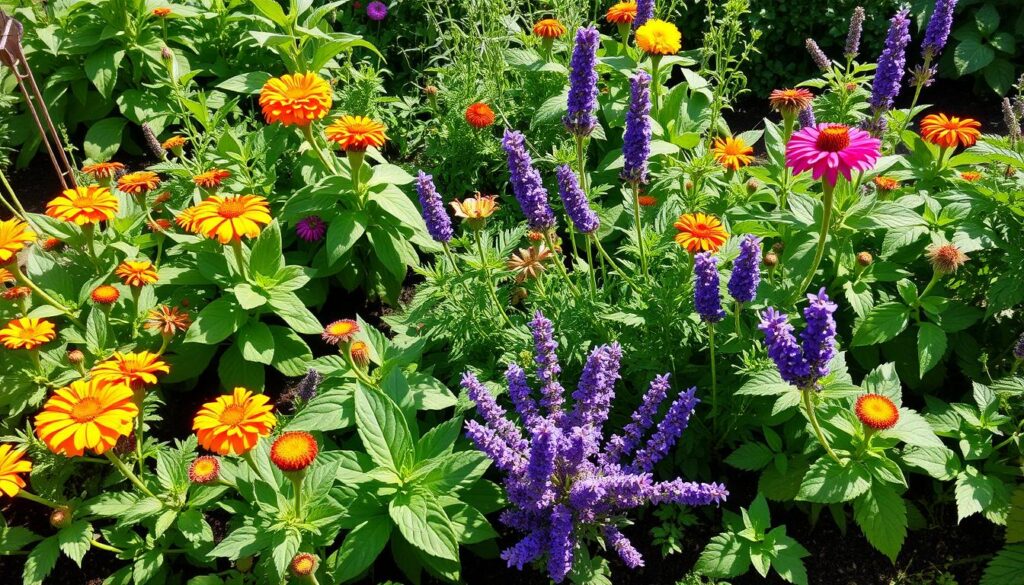
Using Companion Plants to Naturally Repel Pests in Different Garden Types
Companion planting works well in many gardens, like vegetable plots, flower beds, and containers. It helps control pests naturally. By picking the right plants, gardeners can keep their gardens healthy and balanced.
In vegetable gardens, some plants protect veggies from pests. In flower beds, they add beauty and keep pests away. Even in small containers, the right plants can help control pests.
Vegetable Gardens
Here are some good companion plants for veggies:
- Marigolds keep nematodes and other pests away from tomatoes.
- Basil fights off aphids and pests that harm cucumbers and carrots.
- Radish repels cucumber beetles and pests that target squash and cucumbers.
Flower Beds
Companion plants in flower beds are beautiful and pest-repellent. For example:
- Lavender keeps moths and pests away from roses and carnations.
- Chives repel aphids and pests from sunflowers and daisies.
Container Gardens
In containers, companion plants help create a balanced space. Here are a few:
| Companion Plant | Pest Repelled | Container Garden Type |
|---|---|---|
| Basil | Aphids | Herb container garden |
| Marigold | Nematodes | Vegetable container garden |
| Chives | Aphids | Flower container garden |
By using companion plants in different gardens, gardeners can naturally control pests. This approach keeps gardens healthy and balanced.
Maintaining Your Companion Plant Defense System
Keeping an eye on your garden is key to a strong defense system. Look out for pests and diseases. Be ready to add new plants when needed. Organic pest management methods, like using plants to keep pests away, work well.
A healthy soil is vital for your plants. Use composting, mulching, and crop rotation to keep the soil balanced. Beneficial insects for pest control will also help when you attract them with the right plants.
Here are some tips to keep your garden safe:
- Check your garden often for pests and diseases
- Add new plants to keep the ecosystem diverse
- Keep the soil healthy with composting and mulching
By following these tips and using companion planting to deter pests, you can build a strong defense. This will help keep your plants healthy and pest-free.
| Companion Plant | Pest Deterred |
|---|---|
| Basil | Aphids, mites |
| Marigold | Nematodes, whiteflies |
| Chives | Aphids, beetles |
Integrating Beneficial Insects with Companion Planting
Using beneficial insects and companion planting together is a smart way to manage pests. This method uses the natural pest control of beneficial insects and the benefits of companion planting. It creates a strong partnership. By attracting insects like ladybugs and lacewings, gardeners can lower pest numbers. This helps prevent pests and manage pests sustainably.
To keep beneficial insects in the garden, we need to make their homes welcoming. We can do this by adding food like pollen and nectar, and places to hide. Plants like marigolds and basil not only repel pests but also attract beneficial insects. By adding these plants, gardeners can help their gardens grow strong and healthy, reducing the need for harmful chemicals.
- Plant a variety of flowers and herbs that attract beneficial insects.
- Make sure there are places for insects to hide and food for them.
- Build a balanced garden ecosystem that promotes healthy plants and reduces pesticide use.
By using these methods, gardeners can help their gardens thrive. They can manage pests in a way that’s good for the environment. This approach benefits from the help of beneficial insects and natural pest repellent plants.
| Beneficial Insect | Attracted by | Pest Controlled |
|---|---|---|
| Ladybugs | Marigolds, calendula | Aphids, whiteflies |
| Lacewings | Dill, angelica | Thrips, mealybugs |
Troubleshooting Common Companion Planting Issues
When using a companion planting guide, gardeners might face some problems. These issues can affect how well pest-repelling plants work together. It’s key to know what each plant needs and be ready to make changes when needed.
Plant Compatibility Problems
One big issue is when plants don’t get along because of different needs. To solve this, pick plants that like the same conditions and need similar space. Using eco-friendly gardening tips can also help reduce competition.
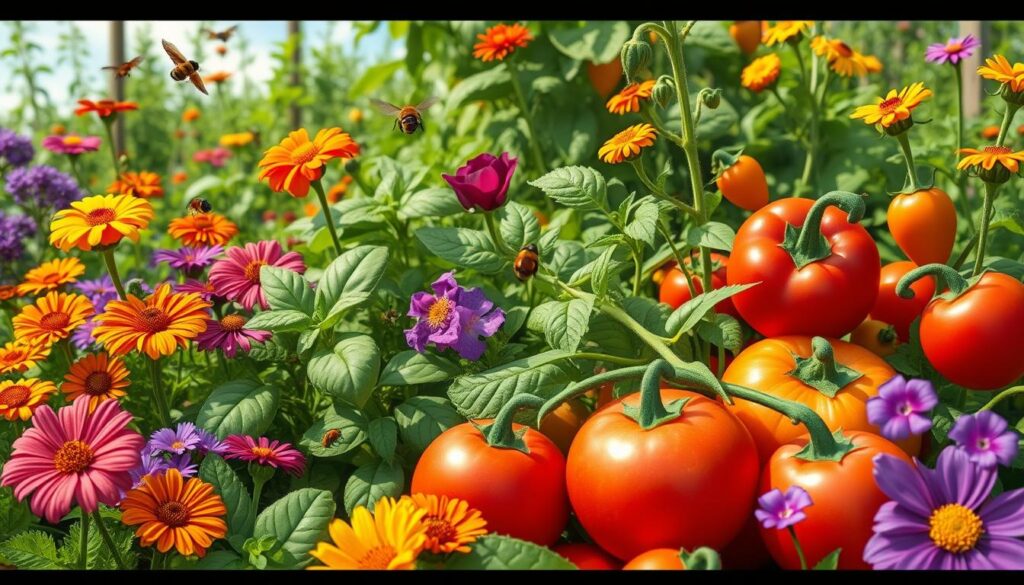
Space Management Challenges
Managing space is another big challenge, mainly in small gardens. To tackle this, gardeners can try vertical gardening. They can also choose plants that do well together, like herbs and flowers.
By following these tips and using a companion planting guide, gardeners can make a garden that fights pests and diseases. It will also support eco-friendly gardening practices.
Best Practices for Long-term Pest Management Success
For long-term pest management success, a holistic approach to gardening is key. This means looking at the whole ecosystem and how parts work together. Keeping soil healthy, saving water, and growing a diverse plant community helps. This way, gardeners can use fewer chemical pesticides and create a balanced garden.
To use pest-resistant companion plants well, gardeners should follow these tips:
- Choose plants native to your area and fit your climate and soil.
- Grow a variety of plants to attract good bugs and increase biodiversity.
- Use repelling pests naturally with companion planting by picking plants that keep pests away, like marigolds and basil.
By sticking to these practices and gardening holistically, gardeners can have a healthy, pest-free garden. They won’t need to rely much on chemical pesticides. It’s also important to keep an eye on pests and the environment, as they can change.
To succeed in the long run, gardeners must stay true to companion planting. They should also keep learning about new methods and research. This way, they can build a garden that’s good for plants and the environment.
| Companion Plant | Pest Repelled |
|---|---|
| Marigold | Nematodes |
| Basil | Aphids |
| Chives | Aphids |
Conclusion
Gardeners are looking for ways to garden that are good for the planet. They are finding that usingcompanion plants
tonaturally repel pests
is key. This method is becoming more important fororganic gardening
By learning aboutcompanion planting
and using it, gardeners can make their gardens strong. These gardens can fight offgarden pests
and diseases well.
This approach has many good points. It means less use of harmful chemicals and a more diverse garden. Gardeners usingnatural pest repellents
will have healthier plants and a cleaner space. They will also feel good about growing a sustainablegarden pest management
system.
With the right knowledge, gardening’s future looks bright. It will be about living in harmony with nature and growing strong gardens.
FAQ
What is the science behind companion planting for pest control?
Companion planting is based on how plants talk to each other and their surroundings. They send out chemicals that can keep pests away or attract good bugs. Knowing how plants defend themselves is key to using companion planting well.
What are the benefits of using companion plants for natural pest management?
Using companion plants helps avoid harmful chemicals. It keeps the garden balanced, improves soil, and makes plants taste better. It also makes your garden look nice and is good for the planet.
What are some essential companion plants that can repel common garden pests?
Some plants, like basil and mint, keep bugs away. Flowers like marigolds and nasturtiums also help. Vegetables like hot peppers and garlic are natural repellents.
How can you create effective plant combinations for pest prevention?
To stop pests, mix different plants that repel them. This means planting herbs, flowers, and veggies together. This makes your garden strong and diverse.
How important is the strategic placement and spacing of companion plants?
Where and how far apart you plant is very important. Knowing the best way to arrange plants helps them work better against pests.
How can you use companion plants to naturally repel pests in different garden types?
Companion planting works in many gardens, like veggie plots, flower beds, and containers. Just pick the right plants for your garden and pests.
How can you maintain your companion plant defense system?
Keeping your garden safe needs regular checks and changes. Watch for pests and diseases, and add new plants when needed. Healthy soil is also key.
How can you integrate beneficial insects with companion planting?
Adding good bugs to your garden is a smart move. Ladybugs and lacewings eat pests. Make your garden welcoming to these helpful insects.
What are some common companion planting issues and how can you troubleshoot them?
You might face problems like plants not getting along or needing more space. To solve these, plan carefully and be ready to make changes. Know what each plant needs.
What are the best practices for long-term pest management success with companion planting?
For lasting success, garden holistically. Keep the soil healthy, save water, and have a variety of plants. Always watch and adjust your garden as needed.

